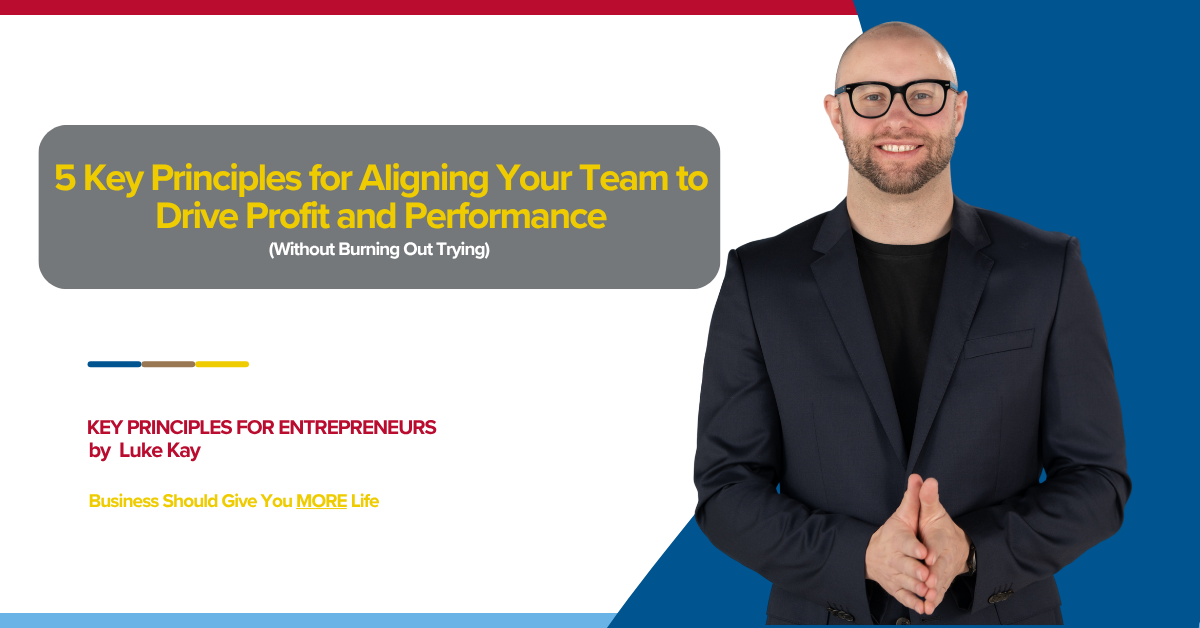
If you’re feeling like you and/or your business is stuck in a rut, chasing updates, fixing mistakes, or repeating yourself, it’s not because you’ve got the wrong people.
It’s because the alignment in your business and your team is off.
When your team does not have absolute clarity on what the business is trying to achieve or how their role connects to the bigger picture, things start to slow down or stall completely.
You’ll see it in missed targets, miscommunication, and it might even give you the sense that everyone is simply operating on auto-pilot, and not in a good way.
Getting your team moving in the same direction is what turns a bunch of people into a proper unit.
But here’s the thing, alignment on its own isn’t enough. You also need ownership. That’s where it all clicks. When everyone knows the goal, understands their part in it, and actually takes responsibility, things start to flow. Work gets done quicker, the atmosphere lifts, and the results speak for themselves.
Let’s break down 5 practical principles that will help you get your team aligned, bought-in, and driving performance that actually shows up in the numbers.
Key Principle #1: Set the Targets, and Make Them Achievable
Imagine playing a sport where no one knows the score, or even which goal they’re aiming for. That’s what running a business feels like when your team doesn’t know your top priorities.
Set clear, measurable targets for the quarter—revenue, profit, retention, delivery, whatever moves the needle. Then make those goals unmissable. Daily stand-ups, weekly scoreboards, visible dashboards—it’s about creating rhythm and repetition.
You want every person in your business to wake up knowing what matters most this week. That kind of focus cuts through the chaos and pinpoints where the business needs to get to.
Key Principle #1 Case Study: Brompton Bicycle
Brompton didn’t grow into a global cycling icon by winging it. Their leadership made company-wide targets hyper-visible. From design to dispatch, every team understood how their actions moved the business forward. That unity powered their international growth—without the wheels falling off.

Key Principle #2: Clarify Roles So There’s No Overlap, No Gaps
You can’t grow a business if everyone’s tripping over each other, or waiting around hoping someone else will get the job done. When people aren’t sure who’s meant to do what, progress stalls and everyone ends up feeling frustrated, starting with you as the business owner.
Clarity means spelling it out: What is this person responsible for? What does a win look like? Where do handovers happen?
Define roles by outcomes, not just tasks. And check in regularly, because as the business grows, so do the roles.
Key Principle #2 Case Study: Oddbox
The sustainability-led veg box company reduced delivery errors and subscriber churn by revisiting team roles. When they clarified ownership across logistics and fulfilment, they didn’t just save time—they elevated customer satisfaction and freed up energy for growth.

Key Principle #3: Build Accountability Into the System (Not Your Shoulders)
Accountability isn’t about pressure. It’s about structure. You shouldn’t have to chase people constantly. Your systems should do that for you.
Keep it short and sharp with a quick weekly catch-up. No need for long meetings, just a focused check-in to see what’s on track and what needs attention. You can use something like Trello, Asana, or even a simple scorecard on paper if that works better.
The agenda? What’s working, what’s not working, how do you all as a team overcome the challenge and what needs support. This rhythm builds trust and creates space for honest updates—not excuses.
Key Principle #3 Case Study: Wild Nutrition
When this UK supplement brand started weekly team huddles, something shifted. Each department tracked three key metrics—and reviewed them consistently. Accountability stopped being a threat and became a habit. It boosted performance and, just as importantly, morale. Wins were shared. Blockers were cleared. Fast.

Key Principle #4: Make Profit Everyone’s Business
Here’s the thing that all business owners should know; most employees want to make a difference, but they don’t always understand how their work links to profit. And when people feel disconnected from results, they disconnect from responsibility.
Break it down. Show how the numbers work. It could be saving a few quid here, selling a little extra there, or making sure customers stick around. When your team sees how those little actions push the business forward, that’s when things really start to click. Then reward that impact.
Recognition, bonuses, profit-sharing, find a system that makes success feel shared.
Key Principle #4 Case Study: JoJo Maman Bébé
This beloved UK retailer drove profit and performance by tying store results to bonuses. When staff saw how better service and efficient stock handling boosted the bottom line, behaviours shifted. They owned their results—and the numbers showed it.

Key Principle #5: Create a Culture of Ownership Through Feedback
Great teams aren’t built in silence.
If your team isn’t used to giving or getting feedback, you’re letting little cracks form in the business without even realising it. Feedback doesn’t have to be scary or harsh, it just needs to be honest, timely, and clear.
Get your leaders into the habit of regular check-ins, weekly one on ones, quick reviews after projects, or a simple “course-correct” when things drift. When feedback becomes part of the normal rhythm, taking responsibility and making improvements becomes second nature.
Key Principle #5 Case Study: Infinity Works
This tech consultancy scaled quickly without losing its cultural edge by training leaders in radical candour, a model for giving direct, honest feedback while still showing care. It helped junior team members step up and created space for new ideas without chaos.

Your Alignment-to-Profit Checklist
- Set and repeat 3 company goals weekly (loud and proud)
- Define every role by outcomes, not just tasks
- Introduce weekly check-ins with scorecards or simple tracking
- Link performance to profit, then share the rewards
- Train leaders to give feedback that grows ownership
Small shifts in structure can unlock massive gains in delivery, energy, and profit.
Take Action
If you’re still the one holding everything together, it’s time for a rethink.
Because the truth is, if your business can’t run without you, then it’s not really a business. It’s a job you’ve built for yourself… with overtime and no off switch.
But it doesn’t have to stay that way.
Want to build a team that drives growth (without you having to push it all uphill)?
Let’s get your business running smoother, not just scraping by. Book a FREE 30-minute Discovery Call, and we’ll take a look at how your team’s set up, spot any gaps, and work out the quickest way to get everyone pulling in the same direction, so you can take a step back without feeling like everything’s about to fall apart.
Visit an Event
You’ve seen the posts, read the testimonials, maybe even followed along online. But there’s no substitute for experiencing our in person business growth MasterCLASSes or quarterly 90-Day Planning Workshops.
Our events are part of our Entrepreneurship Academy or 1-2-1 Business Coaching Programmes, powered by ActionCOACH. You’ll get practical tools, simple systems, and the chance to meet other business owners who are making things happen.
Your first event might just be the spark your business needs.





